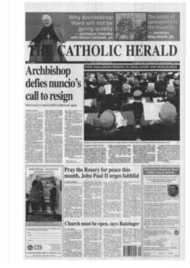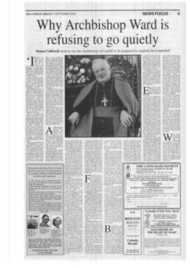Page 9, 5th October 2001
Page 9

Report an error
Noticed an error on this page?If you've noticed an error in this article please click here to report it.
Tags
Share
Related articles
Going Gothic
Brummie Gothic
Pugin And 'the Millionaire Saint'
Getting To Grips With Gothic
Shrines To The Sacraments
`Antient & majestic'
The hurried, misspelt letters of Pugin powerfully convey his belief that the Gothic style was the fullest expression of Catholicism, says Anthony Symondson sj
The Collected Letters of A. W. N. Pugin, edited by Margaret Belcher, Vol 1: 1830-1842, Oxford Univer sity Press £70
4 / am sorry for my bad writing, but really I have so
many letters to write, so much work to do, and get so driven up for time, that my ideas go much faster than the pen, I fear I cut syllables short, but I will be more careful in the future."
There, in a nutshell, A. W. N. Pugin, the Gothic Revival architect, summed up his frenzied life and correspondence. He was writing to his patron, Lord Shrewsbury, for whom he designed his best church. St Giles's, Cheadle, Staffordshire, in 1841. "I hope when Cheadle is finished ... it will be the most perfect thing in England." In hurried, misspelt, unpunctuated prose, Pugin poured out his enthusiasm, didacticism, hopes, fears, zeal, idealism, . prejudice, reverses and triumphs. Margaret Belcher, in the first of five volumes, has edited the letters that cover the years leading to Pugin's conversion and early practice, set against the stresses of domestic life, the death of his first wife, his remarriage and a growing family, and concludes in 1842 when he was established.
Pugin would have achieved little if the Roman Catholic Emancipation Act had not been passed in 1829. He was received into the Church at Salisbury in 1835 and saw his work as building up the waste places, restoring the glories of the Old Faith in its new freedom by re-establishing a connection with the medieval past, and seeing in Gothic architecture the fullest expression of Catholicism. These years offered unprecedented opportunities for building and furnishing new churches.
"The dedication of St Chad's (Birmingham] was a most glorious affair," he told Shrewsbury in 1841, "by far the most solemn function since the good old times in England. Everybody seems pleased, even delighted, and the number of converts to screens, roods etc, immense." Encouraged by Thomas Walsh, Bishop
of the Midland district, it was the first Catholic cathedral to be built in England since the Reformation.
Pugin was not simply content with aesthetic Catholicism. He regarded himself as a teacher combating ignorance and believed that the return to a Christian state was symbolised by a return to Christian architecture. Give to the people the visible forms of medieval piety, and that piety will pour back through those forms into the realities of brotherhood and service.
Pugin's medievalism was discouraged by Nicholas Wiseman who, he told Daniel Rock. Shrewsbury's chaplain, "is evidently quite opposed to English Catholic antiquity & relishes nothing but modern Rome". But Wiseman later recanted, withdrew his opposition to the rood screen in St Chad's, and "seems to have come round completely to the good things & wears the
old chasuble & appareled alb and also a proper Mitre & furthermore approves of the screens so fully I hope we can carry out things in the real spirit" Pugin held the appointment of Profes
sor of Ecclesiastical Antiquities at Oscott, where he enthused the seminarians with medievalist idealism. "You must come and see a function at Oscott," he told his father's friend Edward
Willson, "you would be delighted. The solemnities of our holy religion are better performed there than anywhere on the continent ... and — it is wonderful to see the effect produced even on the catholics when they see their religion in its
antient & majestic garb."
What was generally found in Catholic Europe was quite different. In 1840 Pugin visited St Omers where, he told Shrewsbury, "the glories of catholic
antiquity & Modem trash are surprisingly contrasted. I witnessed a procession for the Fete Dieu in which ecclesiastical ornaments & vestments were burlesqued in the most outrageous
maner. I reserve particulars till I have the honour of seeing your Lordship but such a collection of paper wings sashed and pinked acoloytes petticoat albs board Like chasubles & Dalmatics I have never ,.,
before witnessed & the ,,
Reposoirs were worthy of St Bartholomew's fair." The .,• walls of Alton Towers must, .• have rung with indignation..
While a great part of the letters in this volume comprise professional corre. spondence, there is also —
explained the reality of , Pugin's conversion. It was . ' not merely a matter of exter• nals. The letters show how . •,, he thought and felt. Writing,. to his contemporary, William Osmond, in 1834 he said, "I can assure you , after a most close & impar-.
tial investigation I feel •• •
perfectly convinced the , , roman Catholick church is ,, the only true one — and the, only one in which the grand, & sublime style of church architecture can ever be restored — a very good —
chapel is now building in , the north & when compleat .
I certainly think I shall .• . recant." That chapel was the. great collegiate church built
in 1835 by the Jesuits at Stonyhurst on a scale to match the Established Church. In later years Pugin designed two stained glass , windows for it.
In the background is therising Oxford Move, , ment and the hopes it . : aroused for conversions • and the reunion of the Catholic Church with the Church of England. Pugin's' theories were well received •• • by the Tractarians and he ,.. , designed and decorated articles "that excited the admi•
ration of many" for the , .. rooms of John Rouse Bloxam, Newman's curate ' • and a Fellow of Magdalen. And of the members of the. , . Cambridge Camden Society : he told Bloxam that "they • • have been coming out most , Gloriously ... I think they • , will do immense good". , Reunion did not happen and . Pugin later abandoned his , , , ecumenical hopes. . ,
But the Gothic Revival • • ,.• did, and it is entirely due to Pugin that churches were • 4, liturgically planned and ,, , disposed with pointed arches, brass, dim light, carved marble and stone, embroidery, stencilled walls, encaustic tiles and stained glass.
blog comments powered by Disqus













